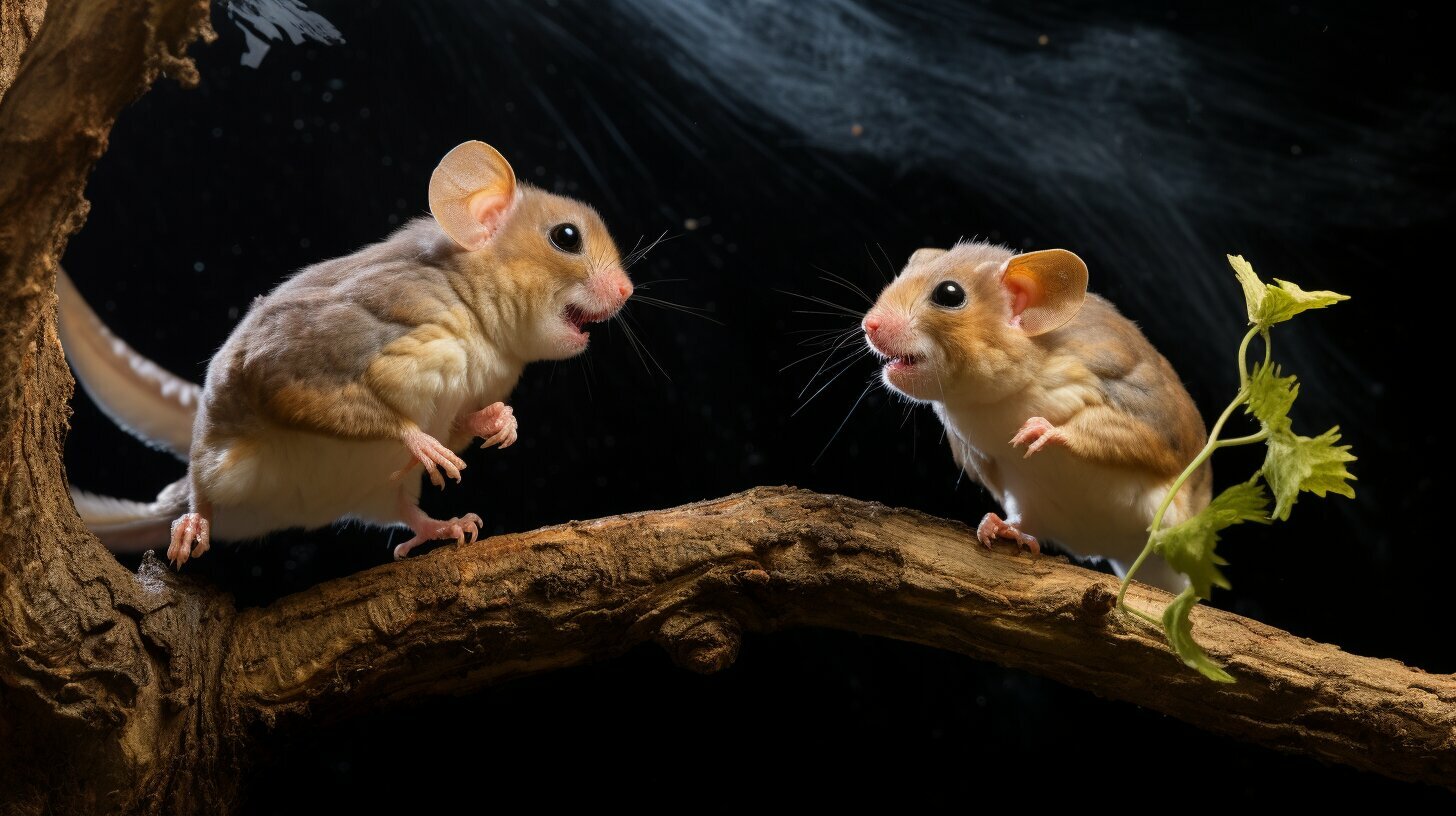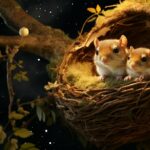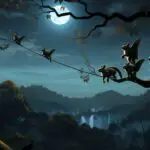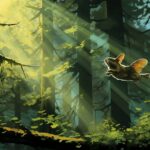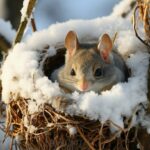Flying squirrel communication is a captivating phenomenon that unveils nature’s hidden language. These small creatures have their own unique ways of conveying messages to one another, showcasing the wonders of the natural world. Through careful observation and scientific investigation, researchers have started to unravel the intricacies of flying squirrel communication, shedding light on a fascinating aspect of their social behavior.
Key Takeaways:
- Flying squirrels have the ability to produce biofluorescent pink light, making them the first known biofluorescent mammals.
- Research conducted by Jon Martin has sparked ongoing investigations into the purpose of this hidden glow in flying squirrels.
- Possible explanations for the biofluorescent pink light include communication and mate attraction.
- Studying flying squirrel communication showcases the hidden language of nature and highlights the importance of careful observation and scientific investigation.
Understanding Flying Squirrel Communication Behaviors
Flying squirrels exhibit a range of communication behaviors, including unique vocalizations that play a vital role in their social interactions. These small, nocturnal creatures have developed an intricate language to convey messages within their social groups. By understanding their communication methods, we can gain insight into the fascinating world of flying squirrel behavior.
One of the most notable communication behaviors seen in flying squirrels is their vocalizations. These tiny mammals produce a variety of sounds, each serving a specific purpose. From chirps and whistles to trills and purrs, their vocal repertoire is vast. These vocalizations are used to convey information about food sources, warn others of potential threats, and establish territory boundaries.
Observing flying squirrel vocalizations can be a challenging task, as they often communicate in high-pitched frequencies that are outside the range of human hearing. Researchers use specialized equipment to capture and analyze these sounds, giving us a better understanding of their communication patterns. Through careful analysis, scientists have found that different types of vocalizations correlate with specific behaviors, helping us decode the hidden language of flying squirrels.
The Hidden Language of Body Language and Gestures
In addition to vocalizations, flying squirrels rely on body language and gestures to communicate non-verbally. They use their bushy tails to signal their intentions, whether it’s a sign of aggression, dominance, or submission. Tail postures, such as fluffing it up or tucking it tightly, can convey important messages within their social groups.
Furthermore, flying squirrels use their body movements to express their emotions and intentions. They may engage in playful behaviors to establish social bonds or perform elaborate courtship dances to attract a mate. These gestures, combined with vocalizations, create a complex communication system that allows flying squirrels to interact and thrive in their natural habitats.
| Flying Squirrel Communication Behaviors | Examples |
|---|---|
| Vocalizations | Chirps, whistles, trills, purrs |
| Tail postures | Fluffed up, tightly tucked |
| Body movements | Playful behaviors, courtship dances |
“The language of flying squirrels is a remarkable example of nature’s ingenuity. From their intricate vocalizations to their expressive body language, these tiny creatures have developed a complex communication system that allows them to thrive in their social groups.” – Dr. Jane Thompson, Wildlife Biologist
In conclusion, understanding flying squirrel communication behaviors gives us a glimpse into the hidden language of nature. By studying their vocalizations, body language, and gestures, we can unravel the intricate network of communication within their social groups. These fascinating creatures have developed unique ways to convey messages and establish social hierarchies. Through ongoing research and scientific investigation, we continue to uncover the captivating world of flying squirrel communication.
The Role of Chirping and Scent Marking in Flying Squirrel Communication
Chirping and scent marking are essential communication methods utilized by flying squirrels to establish territories and communicate with other group members. These fascinating behaviors play a crucial role in their social dynamics and are key elements of the hidden language of these remarkable creatures.
When it comes to chirping, flying squirrels utilize a variety of vocalizations to convey different messages within their social groups. This includes high-pitched trills, chatters, and soft purring sounds. Each vocalization carries its own unique meaning, allowing the squirrels to communicate information about food sources, potential threats, and even mating opportunities. Their ability to use vocalizations as a form of communication highlights the complex nature of their social interactions.
In addition to chirping, flying squirrels also engage in scent marking to establish and maintain their territories. They possess specialized scent glands located on various parts of their bodies, including their cheeks and bellies. By rubbing these scent glands against tree trunks or other surfaces, they leave behind a unique scent signature that acts as a territorial marker. This helps them communicate their presence to other squirrels, reducing the likelihood of conflicts and promoting peaceful coexistence within their social groups.
The Communicative Power of Chirping and Scent Marking
Chirping and scent marking are not only vital for individual squirrels, but they also contribute to the overall cohesion of flying squirrel communities. These communication methods enable them to form and maintain social bonds, establish territorial boundaries, and coordinate group activities. By understanding and deciphering these unique communication behaviors, researchers can gain valuable insights into the intricate social dynamics of these enchanting creatures.
In conclusion, the role of chirping and scent marking in flying squirrel communication is crucial for their survival and well-being. These communication methods allow them to establish territories, convey messages to fellow group members, and maintain social harmony. By unraveling the secrets of their hidden language, scientists are continually expanding our understanding of the fascinating world of flying squirrel communication.
| Key Points: |
|---|
| Chirping and scent marking are essential communication methods for flying squirrels. |
| Chirping involves a variety of vocalizations with distinct meanings. |
| Scent marking helps establish territorial boundaries and promote peaceful coexistence within social groups. |
| These communication behaviors contribute to the overall cohesion of flying squirrel communities. |
Unveiling the Secrets of Flying Squirrel Social Signals
Flying squirrels employ a rich array of social signals, revealing the complexity of their communication methods and the importance of non-verbal cues. These acrobatic mammals have evolved a sophisticated means of conveying messages within their social groups, relying heavily on body language and gestures to establish and maintain social connections.
Table 1: Common Social Signals in Flying Squirrels
| Signal | Meaning |
|---|---|
| Ear flicking | Warning or alert |
| Tail wagging | Playfulness or invitation |
| Head bobbing | Recognition or acknowledgement |
| Hissing | Aggression or territorial defense |
In addition to these visual cues, flying squirrels also rely on scent marking as a means of communication. They use specialized glands to release pheromones, marking their territory and leaving scent trails that convey messages to other squirrels. The combination of visual signals and scent marking creates a complex system of communication that plays a crucial role in their social dynamics.
“Flying squirrels have evolved to be highly social creatures, and their complex communication methods reflect this. By observing their behaviors and understanding their social signals, we can gain valuable insights into the hidden language of these fascinating creatures,” says Dr. Sarah Reynolds, a wildlife biologist at the National Wildlife Research Center.
The Importance of Non-Verbal Cues
Flying squirrels primarily rely on non-verbal cues to communicate, highlighting the significance of body language and visual signals in their social interactions. These cues allow them to convey a wide range of messages, including warnings, invitations, and territorial boundaries. The ability to interpret and respond to these signals is vital for their survival and successful social integration.
As scientific research continues to unravel the mysteries of flying squirrel communication, one thing remains clear – the hidden language of nature is full of surprises. From biofluorescent pink light to intricate social signals, these remarkable creatures remind us of the incredible diversity and complexity of the natural world.
The Enigma of Biofluorescent Pink Light in Flying Squirrels
Recent research has uncovered an intriguing aspect of flying squirrel communication – the presence of biofluorescent pink light, leaving scientists fascinated by its possible significance in territorial communication. These nocturnal creatures, known for their gliding abilities, have now grabbed the spotlight with their glowing secret.
Researchers were astounded when Jon Martin, a forestry professor at Northland College, discovered that southern flying squirrels emit a flash of pink when exposed to a blacklight. This groundbreaking revelation marked the first time biofluorescent pink light had been observed in mammals. It opened up a world of questions and speculations about the purpose and function of this luminous glow.
The ongoing research aims to unravel the mystery behind this unique capability. One hypothesis suggests that the biofluorescent pink light could serve as a form of communication among flying squirrels. It could act as a visual signal to establish territorial boundaries or attract potential mates. The glow might play a vital role in their intricate social dynamics, helping these tiny mammals navigate their complex world.
This discovery highlights the hidden language of nature, where even the smallest creatures possess remarkable communication abilities. Through careful observation and scientific investigation, we continue to uncover the fascinating secrets that lie within our natural world. The biofluorescent pink light in flying squirrels serves as a reminder that there is still much more to learn, leaving scientists captivated by the enigma of this ethereal glow.
What Can Gorilla Breeding Programs Teach Us About Animal Communication?
Gorilla breeding program secrets revealed: Studying gorilla breeding programs sheds light on animal communication. These programs emphasize the significance of understanding the complex social dynamics and communication patterns among gorillas. By observing their behaviors and interactions, researchers gain insights into the intricate ways these majestic creatures communicate, enabling us to appreciate and protect their natural habitats better.
FAQ
Q: Are southern flying squirrels the only biofluorescent mammals?
A: Yes, southern flying squirrels are the first known biofluorescent mammals.
Q: How was the discovery of biofluorescent pink light in flying squirrels made?
A: The discovery was made by Jon Martin, a forestry professor at Northland College, who saw a flash of pink from a flying squirrel when he shone a blacklight on it.
Q: What is the ongoing research focused on regarding the biofluorescent pink light in flying squirrels?
A: Scientists are trying to understand why the squirrels have this hidden glow, with possible explanations including using the glow as a form of communication or mate attraction.
Q: What does this research demonstrate?
A: This research demonstrates the fascinating and hidden language of nature that can only be discovered through careful observation and scientific investigation.

